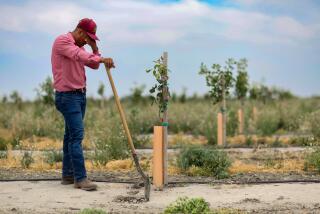Dispute Muddies State’s Waters
On Aug. 4, farmers on the west side of the San Joaquin Valley staged a bold and surprising attack on the water rights of their brethren on the east side of the valley. Chairman Kole M. Upton of the east side’s Friant Water Users Assn. said that, in mounting their “sneak attack,” Westlands leaders “have pitted farmer against farmer and east side versus west side in a death struggle.”
It wasn’t Pearl Harbor, but this battle could undermine years of cooperative efforts to better conserve and allocate water in California to the benefit of farmers, urban users and the environment. Unless a truce can be called soon, the San Joaquin battle could drag out for years in the state water bureaucracy and the courts. Ultimately, the quality and quantity of water delivered to millions of homes in Southern California could be affected. This is a fight that California cannot afford.
The belligerents are two giants of agriculture in California and the nation. About 6,000 farmers in Westlands on the west side of the fertile valley cultivate 600,000 acres of crops, much of it cotton and tomatoes. Westlands has a contract with the U.S. Bureau of Reclamation to receive more than 1 million acre-feet of water a year imported from Northern California by the Central Valley Project. That’s enough to supply the household needs of 2 million families. But for a variety of reasons, including environmental demands in the Sacramento-San Joaquin Delta, the giant district has received only about half its allotment in recent years.
On the east side, about 15,000 smaller farms within the Friant area have drawn an average 1.5 million acre-feet from the San Joaquin River for half a century, also under contract with the Bureau of Reclamation. Until now, no one had ever disputed the east side farmers’ right to that water.
What Westlands did on Aug. 4 was to file a petition with the state Water Resources Control Board for the right to about one-third of the east side water, or roughly 500,000 acre-feet in a normal year. Declaring it “a card Westlands had to play,” district officials based their claim on obscure and little-used “area of origin” water laws. These laws were designed primarily to protect portions of Northern California against losing too much of their surplus waters to the south. Since parts of Westlands are adjacent to or near the lower San Joaquin River, the west siders are claiming to be within the river’s area of origin.
On the surface of it, those laws were never meant for such use, but Westlands General Manager Tom Birmingham believes his agency has a good chance of winning.
One immediate result of a Westland’s victory would be the end of a creative joint plan by farmers and environmentalist to return water to the lower San Joaquin, which normally dries up in summer. A proposal to send the pristine water of the Sierra part of the San Joaquin south to the Metropolitan Water District of Southern California in exchange for saltier MWD water from the delta would also die. While the delta water is not so good for drinking, it could irrigate crops.
For now, stunned California water interests aren’t sure what’s going to happen, or when. But unless there is a speedy resolution of this cynical neighbor-versus-neighbor water grab, years of careful work could unravel, and the state’s water future may be racked by unrest, distrust and legal chaos.
More to Read
Sign up for Essential California
The most important California stories and recommendations in your inbox every morning.
You may occasionally receive promotional content from the Los Angeles Times.










